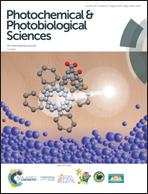BODIPY-embedded electrospun materials in antimicrobial photodynamic inactivation†
Abstract
Drug-resistant pathogens, particularly those that result in hospital acquired infections (HAIs), have emerged as a critical priority for the World Health Organization. To address the need for self-disinfecting materials to counter the threat posed by the transmission of these pathogens from surfaces to new hosts, here we investigated if a cationic BODIPY photosensitizer, embedded via electrospinning into nylon and polyacrylonitrile (PAN) nanofibers, was capable of inactivating both bacteria and viruses via antimicrobial photodynamic inactivation (aPDI). Materials characterization, including fiber morphology and the degree of photosensitizer loading, was assessed by scanning electron microscopy (SEM), thermal gravimetric analysis (TGA), and UV-visible diffuse reflectance spectroscopy (UV-Vis DRS), and demonstrated that the materials were comprised of nanofibers (125–215 nm avg. diameter) that were thermostable to >300 °C. The antimicrobial potencies of the resultant Nylon-BODIPY(+) and PAN-BODIPY(+) nanofiber materials were evaluated against four strains of bacteria recognized by the World Health Organization as either critical or high priority pathogens: Gram-positive strains methicillin-resistant S. aureus (MRSA; ATCC BAA-44) and vancomycin-resistant E. faecium (VRE; ATCC BAA-2320), and Gram-negative strains multidrug-resistant A. baumannii (MDRAB; ATCC BAA-1605) and NDM-1 positive K. pneumoniae (KP; ATCC BAA-2146). Our results demonstrated the detection limit (99.9999%; 6 log units reduction in CFU mL−1) photodynamic inactivation of three strains upon illumination (30–60 min; 40–65 ± 5 mW cm−2; 400–700 nm): MRSA, VRE, and MDRAB, but only minimal inactivation (47–75%) of KP. Antiviral studies employing PAN-BODIPY(+) against vesicular stomatitis virus (VSV), a model enveloped virus, revealed complete inactivation. Taken together, the results demonstrate the potential for electrospun BODIPY(+)-embedded nanofiber materials as the basis for pathogen-specific anti-infective materials, even at low photosensitizer loadings.

- This article is part of the themed collection: New and innovative applications of Photodynamic Inactivation of microorganisms


 Please wait while we load your content...
Please wait while we load your content...